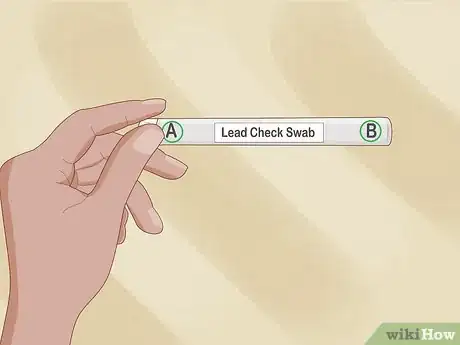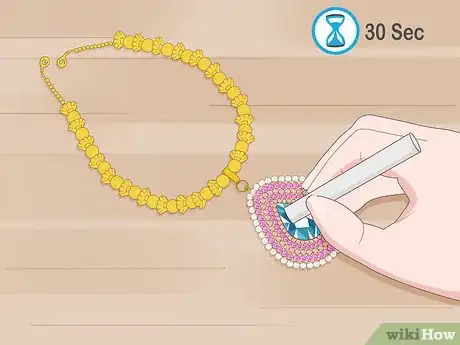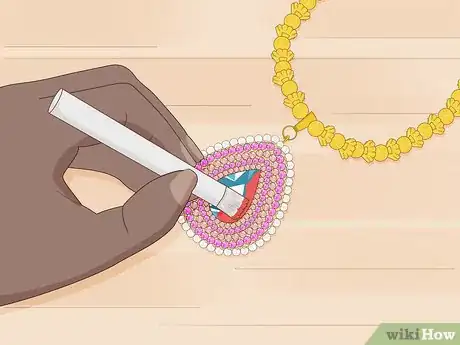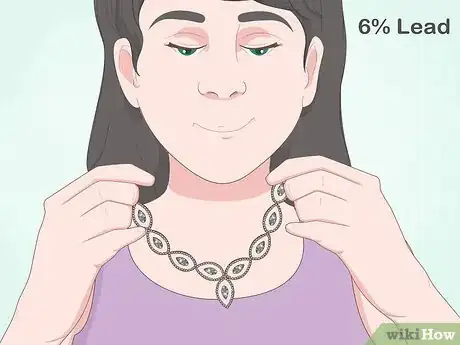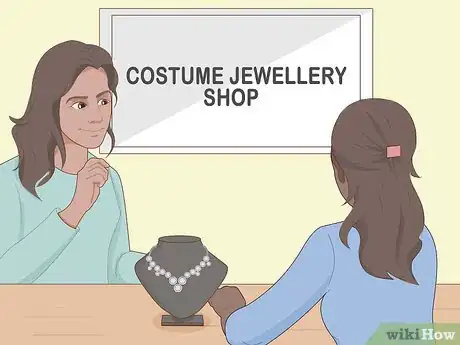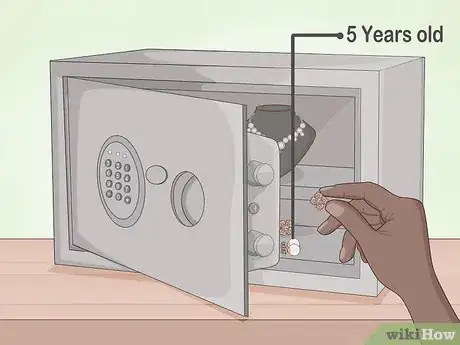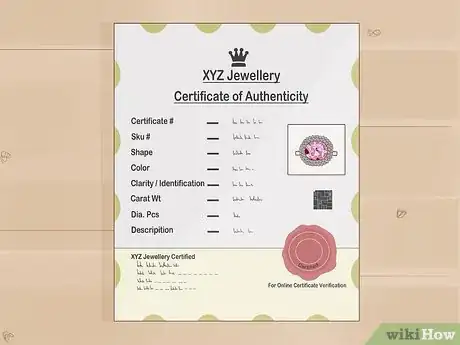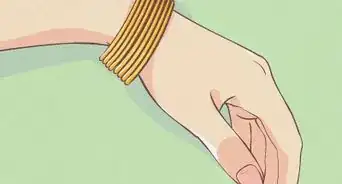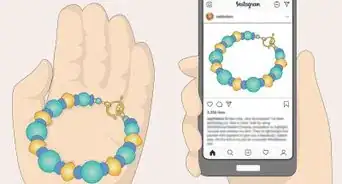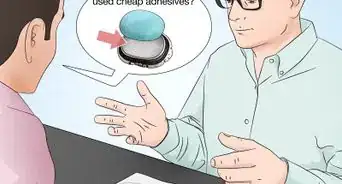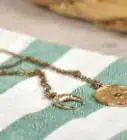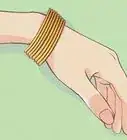This article was co-authored by wikiHow Staff. Our trained team of editors and researchers validate articles for accuracy and comprehensiveness. wikiHow's Content Management Team carefully monitors the work from our editorial staff to ensure that each article is backed by trusted research and meets our high quality standards.
This article has been viewed 56,285 times.
Learn more...
Lead is often used to shape and stabilize jewelry, and is very common in vintage and plastic pieces. Swab tests can be used to quickly identify the presence of lead in jewelry, or you can pay an accredited lab for a more extensive test. A lead quantity under 5,000 ppm is considered safe, but any amount of lead is dangerous if it is absorbed by the body. Test and take care of lead-based jewelry to keep yourself safe.
Steps
Doing a Swab Test
-
1Purchase a lead swab test kit. Small test kits cost about $5 USD per swab and are available for home use. You can find them at most hardware stores. These kits are often used on painted surfaces and won’t leave any permanent marks on your jewelry.[1]
- Swab tests are easy and inexpensive, but they can’t give you a precise estimate of how much lead is in your jewelry.
- Swabs only reach the surface of the jewelry, so it won’t detect lead components deeper inside the piece.
- Swab tests also can be inaccurate. Some tests may give you a false reading, suggesting an item has lead in it when it doesn’t.
-
2Crush the ends of the testing tube. Take 1 of the testing tubes out of the packaging. The tube will have a swab inside of it, but don’t remove it yet. Find the areas labeled “A” and “B” on the tube. Press down hard on both spots at the same time.[2]Advertisement
-
3Shake the tube twice while gently squeezing it. Orient the tube so the swab end points down to the ground. Keep your fingers over the crush points but loosen your grip until you are lightly squeezing the tube. Then, shake the tube twice.[3]
- Yellow liquid should begin flowing through the tube, reaching the end of the swab.
- Releasing the liquid activates the swab. An activated swab needs to be used right away.
-
4Rub the swab onto the jewelry for 30 seconds. Choose a wide, visible area on your jewelry. Continue squeezing the tube as you spread the liquid over the spot. After 30 seconds have elapsed, the test will be complete.[4]
- The applicator may leave behind some liquid on the jewelry. This is normal.
-
5Look for a pink or red color to indicate the presence of lead. If your jewelry contains lead, the testing liquid will change color. You may see a pink or red color on your jewelry. The swab tip should also change from yellow to pink or red.[5]
- The color turns darker as the test detects more lead. Red indicates a higher lead content than pink.
-
6Test the confirmation card if the result is negative. Each testing kit comes with small cards featuring a series of dots. If your swab stayed yellow, use it to color 1 of the dots. The dot should turn pink or red, proving that the test was a success.[6]
- If the dot stays yellow, the applicator failed. Retest your jewelry with a new swab.
-
7Wash the liquid off your jewelry. You can clean off your jewelry with a little bit of water and a damp microfiber cloth. Make a mixture of water and mild dish soap to treat any stubborn spots. To clean stubborn spots, try using specialty cleaners.
- For gold and platinum, mix 2 drops of mild dish soap and a drop of ammonia in a bowl of warm water. Scrub it with a microfiber cloth.[7]
- Dip silver in a commercial polish. For the best results, follow the directions on the label.
- For titanium and other metals, mix 2 drops of a mild dish soap in warm water. Scrub the metal with a microfiber cloth.
Getting a Lab Test
-
1Find a lead-testing lab in your area. Search online for labs that test the lead content in jewelry. These labs are scattered across the world. Each lab has different testing policies and equipment, so you should contact them to discuss the procedures before turning over your jewelry. Ask them about what test they use, how it will affect your jewelry, and how much it costs.[8]
- Consult your local government, since they may keep a list of trustworthy testing labs.
- For example, you can call 1-800-424-LEAD in the U.S. to find labs.
-
2Submit the jewelry to the testing facility. If the facility is near you, you can bring the jewelry to them. Otherwise, ship it through the mail. Speak with a lab representative or visit their website online to find their shipping address.
- Make sure you speak to the company about having your jewelry tested before sending it.
-
3Order a Fluorescence Spectrometry (XRF) test for your jewelry. Lab technicians use an XRF test to tell you what your jewelry is made of. They scan your jewelry with a harmless X-ray. The test results indicate how much of each component is in your item. Other tests damage your jewelry, so stick with an XRF test if you want your jewelry back.[9]
- XRF tests cost approximately $100 USD.
- Acid dissolve tests are cheaper, but they ruin your jewelry. Currently, it is the only alternative to an XRF test.
-
4Wait 2 weeks for the test results. Give the lab time to perform the test. It should take about a week, and then the lab will send the jewelry back a week after that. When you get the item back, the test results should be included with it. You will get a sheet of paper listing the percentage of each metal in the jewelry.
- Lab tests are much more accurate and extensive than swab tests.
- The time you have to wait for the test may vary depending on how busy the lab is.
Avoiding Dangerous Jewelry
-
1Dispose of 10% lead jewelry as hazardous waste. Avoid throwing jewelry into the garbage if it has lead in it. Contact your local government to locate hazardous waste facilities and pick-up days. Let them take the jewelry so it doesn’t go into a landfill or get picked up by a child.
- If you don’t feel safe having a piece of jewelry, get rid of it no matter what the lead level is. Always give it to a hazardous waste facility.
-
2Avoid wearing jewelry that is 6% lead or higher. Jewelry with a 6% lead content is usually safe to wear without noticeable side effects. However, lead may be absorbed through your skin. Wear jewelry with little to no lead in it to prevent this from happening.
- Any amount of lead in the body can lead to negative health effects, such as fatigue, loss of concentration, and seizures.[10]
- For body piercings, the jewelry should never have lead in it.
-
3Avoid costume jewelry sold at retail stores. Costume jewelry is imitation jewelry made with cheaper materials. This jewelry is inexpensive, often less than $10 USD, so it is given to children. This can be dangerous, since lead is often used to strengthen the plastic. Lead may also be in the paint.[11]
- This jewelry, such as what you see at most general stores, is labeled as safe to wear because it doesn’t cause visible harm when worn normally.
- Items from countries with lax regulations, such as China, are more likely to contain lead.
-
4Store jewelry more than 50 years old in a locked box. Jewelry more than 50 years old is considered vintage. In the past, people were less aware of the dangers of lead, so lead usage was more widespread. All vintage jewelry should be locked up in a protected spot out of the reach of children.
- The older the jewelry is, the more likely it is to have lead.
-
5Purchase jewelry from stores that document their items. If you want jewelry with a safe lead level, get it from a trustworthy source. Certified jewelers, as well as positively-rated online sites, should be able to tell you how your jewelry was made. These places provide documentation showing where the material came from and how much of each component was used to make the item.
- Research the store brand online to learn about their policies as well as comments from other customers.
-
6Tell children not to put jewelry in their mouths. If you let a child handle a piece of jewelry, stop them whenever you see them sucking or chewing on the jewelry. Even children as old as 11 or 12 may feel tempted to do this. They will absorb whatever lead is on the jewelry. If the jewelry splinters, they may swallow it.
- All children are different, so only you can decide when a child is ready for jewelry.
- Avoid cheap costume jewelry until you are sure your child can wear it safely.
Warnings
- Be aware of the various components of jewelry. Additional elements, such as Swarovski crystals, may also be made with lead.⧼thumbs_response⧽
- If someone is exposed to lead, call your local poison control center or take them to a doctor immediately.⧼thumbs_response⧽
References
- ↑ https://www.epa.gov/sites/production/files/documents/3M-leadcheck-report.pdf
- ↑ https://www.emlab.com/m/store/LeadCheck%20Swabs%20Instructions.pdf
- ↑ https://www.emlab.com/m/store/LeadCheck%20Swabs%20Instructions.pdf
- ↑ https://www.emlab.com/m/store/LeadCheck%20Swabs%20Instructions.pdf
- ↑ https://www.emlab.com/m/store/LeadCheck%20Swabs%20Instructions.pdf
- ↑ https://www.emlab.com/m/store/LeadCheck%20Swabs%20Instructions.pdf
- ↑ https://www.goodhousekeeping.com/home/cleaning/tips/a25736/how-to-clean-jewelry/
- ↑ https://dtsc.ca.gov/frequently-asked-questions/
- ↑ http://www.oregon.gov/oha/PH/HEALTHYENVIRONMENTS/HEALTHYNEIGHBORHOODS/LEADPOISONING/PARENTSFAMILIES/Documents/nchh_factsheet_teting_consumer_products.pdf

